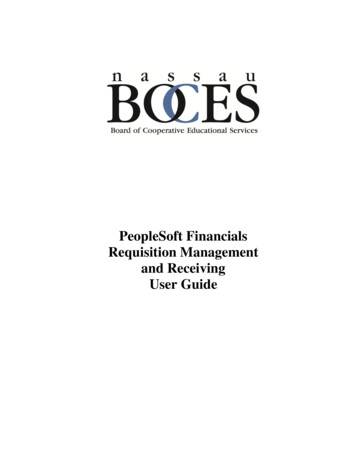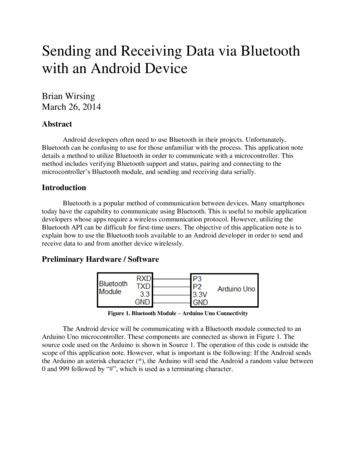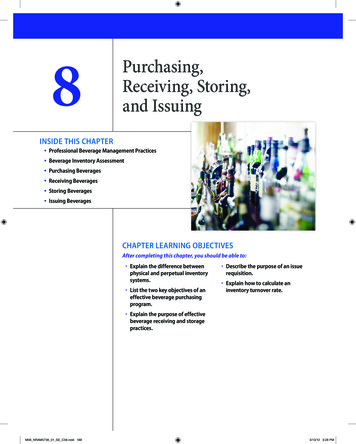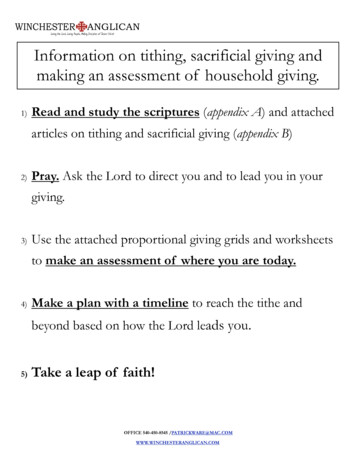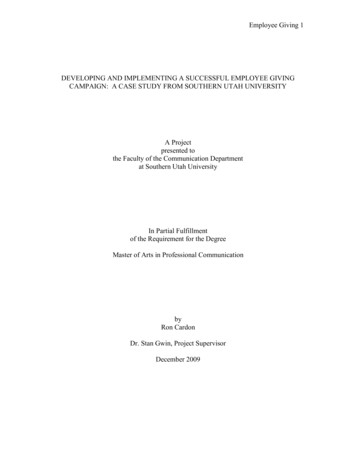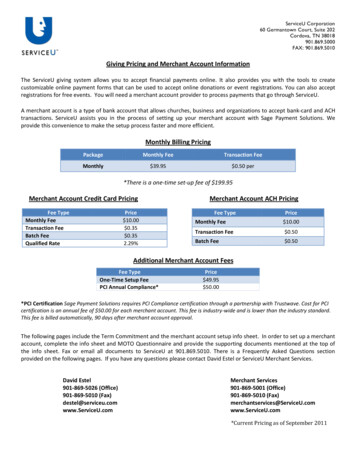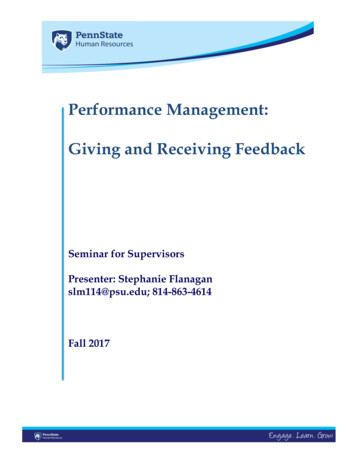
Transcription
Performance Management:Giving and Receiving FeedbackSeminar for SupervisorsPresenter: Stephanie Flanaganslm114@psu.edu; 814-863-4614Fall 2017
2017 The Pennsylvania State University. All rights reserved.Requests for permission to reuse these materials may be directedto: Workplace Learning & Performanceat learning@psu.edu or 814-865-8216.Accommodation Statement/Alternative Media StatementThe Pennsylvania State University encourages qualified persons with disabilities to participatein its programs and activities. If you anticipate needing any type of reasonableaccommodation (e.g. materials in alternate format, sign language interpreter, etc.) toparticipate in Penn State Human Resources Talent Management program you plan to attend,please contact us as far in advance as possible so that we can have the appropriate reasonableaccommodations in place for you.Contact Talent Management at 814-865-8216 (or learning@psu.edu) to request reasonableaccommodations or if you have questions related to requesting reasonable accommodations orthe physical accessibility of the program site. This publication is available in alternative mediaon request.Giving & Receiving FeedbackiiTalent Management
Today’s session will help you to: Gain understanding for how to effectively give and receive feedback Identify your role and responsibilities related to giving and receiving feedback Familiarize yourself with feedback models and best practicesDuring this session I will continue to provide information about Penn State’sperformance management program and review the immediate next steps in the process.Giving & Receiving Feedback1Talent Management
The Performance Management Cycle1. SettingGoals andExpectationsDevelopingEmployees(Ongoing)2. Ongoing3. Appraisal &Review andRewardFeedbackCoachingSetting Goals &Expectations1. Clearly communicate expectations re: jobresponsibilities and competencies (skills) andbehaviors2. Communicate how individual goals align withdepartment and organization goals3. Help your employees set clear, measurableperformance goalsOngoingReview andFeedback1. Holds people accountable for meetingperformance goals and objectives2. Provides constructive feedback to help staffimprove performance3. Takes appropriate action to address poorperformanceAppraisal &Reward1. Conducts thorough annual performance reviews2. Assesses individuals fairly3. Differentiates high performers appropriatelyGiving & Receiving Feedback2Talent Management
Roles in Giving and Receiving Effective FeedbackStaff Member Monitor own performance, seek performance information, apprise supervisor ofsuccesses, shortcomings, and needs Act on feedback receivedSupervisor Provide clear feedback on an ongoing and often informal basis Ensure that staff member understands expectationsShared (Staff Member and Supervisor) Agree upon a joint feedback process(i.e., when and how feedback will be exchanged on a one-on-one basis) Assume best intentionsInstitution Create a consistent language for getting and giving feedback Establish a “No Fear” culture where staff can feel comfortable sharing and receivingfrank feedback Ensure supervisors model a feedback cultureGiving & Receiving Feedback3Talent Management
The Performance Management Cycle:Ongoing Feedback and CoachingFeedback has a direct impact on our work: Gives us specific information to help us improve Makes performance expectations clear from the start Heightens efficiency by reducing resentment, buildup, etc. Strengthens relationshipsBenefits of Positive Feedback Gives clarity to the employee about good performance. Creates enthusiasm. Builds confidence and self-esteem. Increases appropriate risk-taking and innovation. Demonstrates care and involvement. Makes an employee feel acknowledged.When Positive Feedback is appropriate When used to recognize specific job performance that has met and/or exceededexpectations. (It reinforces and motivates.)Example of Positive Feedback: “The budget estimates you presented at the last staffmeeting were very detailed and gave us good criteria for decision-making.”Benefits of Developmental Feedback It lets people know how to execute a task more effectively. It steers actions; communicates what needs to change. It increases the person’s self-awareness. It is the foundation of all development. It gives a bigger picture to the employee.When Developmental Feedback is appropriate When used to help an employee monitor and correct his or her own behavior.Example of Developmental Feedback: “My expectation was that you would provide uswith more details on the event budget. Because we didn’t have enough information, wewon’t be able to make our final decisions until later this week. What can you do to ensurethat we will have the correct information?”Giving & Receiving Feedback4Talent Management
YOUFeedback Reflection:Write the initials of the people that you work with in the shapes provided, including directreports, peers, your manager, customers/clients, etc. Then for each person, answer thequestions:“Are you comfortable providing them with direct, constructive feedback?” If so, draw asolid arrow from you to their shape. If not, draw a dashed arrow.“Are you comfortable receiving direct, constructive feedback from them?” If so, draw a solidarrow from their shape to you. If not, draw a dashed arrow.What does your reflection tell you?Giving & Receiving Feedback5Talent Management
Feedback Framework:Feedback is an essential component of a learning and performance culture. The frameworkassists in preparing to deliver feedback effectively.Feedback is Most beneficial if on-going (which ensures no surprises) Intended to support employee performance and development Helpful and applies to both positive and constructive situationsCopyright 2003 by The Segal Group, Inc., the parent of The Segal Company which includes its division, Sibson Consulting. All rightsreserved. Used with permission by Sibson Consulting.Giving & Receiving Feedback6Talent Management
Let’s assume you are Jason’s supervisor and have some positive feedback to provide:Giving & Receiving Feedback7Talent Management
Let’s assume you are Anna’s supervisor and have some constructive feedback to provide:Examples used with permission from Sibson ConsultingGiving & Receiving Feedback8Talent Management
Using the Feedback Framework:It’s your turn to try!To deliver positive feedback to Jerry:Jerry is a relatively new member of your team who hasn’t had the opportunity to work on the “front lines” yet. The otherday he stepped in for a colleague who called in sick and dealt with a notoriously difficult customer with diplomacy andpatience.Describe the standards or expectations you have forthe situation.1. State yourExpectations2. Describe YourObservations3. Share yourAssessmentTell the employee what s/he did that you want to givefeedback on. Be Specific. Focus on Behavior. Giveexamples.Describe how the behavior impacted the departmentand/or Penn State. Be objective.Express your appreciation.4. ExplainConsequenceGiving & Receiving Feedback9Talent Management
Using the Feedback Framework:It’s your turn to try!To deliver constructive/developmental feedback to Susan:Susan is a junior member within your unit’s marketing department. Writing and sending emails and memos internallyand externally is an important part of her job. Her writing lacks structure and is too wordy. People tend to delete heremails before they are read.Describe the standards or expectations you have forthe situation.1. State yourExpectations2. Describe YourObservations3. Share yourAssessment4. ExplainConsequenceTell the employee what s/he did that you want to givefeedback on. Be Specific. Focus on Behavior. Giveexamples.Describe how the behavior impacted the departmentand/or Penn State. Be objective.If the behavior should be changed, offer suggestions onwhat to do differently or how to improve.Remember: Every discussion will look a little different, depending on the situation. Thereceiver of your message will undoubtedly interject at many points in between steps.Whenever s/he starts talking, let him/her finish and then REPHRASE what they’ve said sos/he knows you got it.Giving & Receiving Feedback10Talent Management
Avoid Common Feedback Pitfalls Reluctance to discuss problems openly and on a timely basisLooking only at extreme behavior, whether good or bad, and ignoring all othereffortsLacking the courage to differentiate performance, either to avoid morale problemsor to avoid having difficult conversationsComparing people to each other rather than against their own goals/ expectationsGiving feedback without inviting and listening to the employee’s commentsNot confirming mutual understanding of expectations in the first placeJumping to conclusions or making evaluations without factsWhat gets in your way of providing feedback?What actions can you take in order to avoid those pitfalls in the future?Remember, giving feedback well begins with following good practices. Practice andexperience will help you become more skilled and comfortable in giving feedback.By providing timely, constructive, and candid feedback to your employees about theirperformance and career objectives, you will be an important part of their development andsuccess.Giving & Receiving Feedback11Talent Management
Feedback ChecklistFeedback from You as a Supervisor Do you provide clear expectations and observations?Do you communicate your assessments?Do you hold back because of fear of the staff’s response?Do you feel that feedback is a burden?Are conversations thorough?Do you provide feedback within a short time after the event?Feedback for You as a Staff Member How often do you ask for feedback?Do you ever get defensive?Do you ask for more detail?Are conversations thorough?Do you ensure that expectations are clear?Do you set goals for improvement?Do you follow up to get additional feedback on progress?Giving & Receiving Feedback12Talent Management
Guidelines for Feedback Success:1. Act sooner rather than later2. Check your intentions3. Dialogue! Treat feedback as a shared responsibility4. Confirm mutual understanding and invite new information; probe for facts5. Don’t rely too much on a form6. Keep your emotions in check7. Respect differencesTips for Receiving Feedback Successfully1. Ask for feedback on an ongoing basis2. Do not reject feedback. Assume best intentions.3. Listen for understanding. Clarify what the feedback means.4. Respond to feedback. Share your own views. Jointly agree on ways to improve.5. Thank the person for giving the feedback. Show appreciation.Giving & Receiving Feedback13Talent Management
Managing ReactionsActively listen to the individual’s perspective, handle reactions and gainacknowledgement that the situation exists:Acknowledge, Reflect:“Sounds as though you have a concern ”“I’m hearing that you are frustrated ”Understand your Employee’s Perspective“Tell me more about that.”“Help me understand with an example of ”Be Straight ForwardUse examples to reinforce your assessment (directly observable data)Restate the impactKeep the Discussion on Track“Let’s focus on your review right now.”“Let’s talk about that in our weekly update meeting.”“I appreciate your telling me that, is there anything else you’d like to say?”“I sense this is an important topic with a lot of emotion around it. I’d like to schedule anothertime for us to continue this conversation.”When handling difficult reactions:– Be aware of your own feelings and anticipate how you will respond to youremployee’s reactions– Make sure that the employee knows she/he is responsible for improvedperformance– Offer support– Actively listen to your employee’s perspective– Gain acknowledgement that the situation exists– Stay firm in your decisionHelping an employee modify difficult reactions is a process that is rarely completed in asingle meeting. Continue to monitor and work with your employee afterward toenhance and sustain acceptance of their ownership of performanceGiving & Receiving Feedback14Talent Management
Managerial CourageMost employee attitude and skill surveys have items regarding how employees feelabout the amount and quality of feedback they’re getting, and how they feel about theirsupervisor’s interests in their development, training and careers. These items usuallyscore low in most organizations. Among the lower rated items are: encourages andaccepts constructive criticism; gives consistently fair performance feedback; dealseffectively with performance problems; talks to me honestly about my career, tells mewhat I need to do to get ahead, and gives developmental performance feedback in atimely manner.Most managers don’t want to create bad feelings. They want to avoid disruptions in theboss/employee relationship, and in the work. They want to be able to manage thetiming of events---so they delay delivering bad news. All very human and unfortunate.Some managers even feel it’s “humane” to soften bad news. They don’t want to be thecause of stress, anxiety and trouble. They believe it is being sensitive and empathetic towithhold and delay bad news, and rationalize holding back on their true feelings aboutan employee’s performance and potential.What is really fair and humane? What is the right thing to do? What do employeeswant? What do employees deserve? What serves the organization best?Most managers know the answer. Most employees know the answer. It’s telling thetruth. It’s being open, honest, direct and timely. Employees deserve the truth so theycan work on their issues and problems and have more control over what happens tothem. Employees deserve to know where they stand.It’s a prime responsibility of managers to tell them the truth, to call performance andpotential as they really see it, to give constructive and accurate feedback on a timelybasis. And ultimately, to pay, reward and promote for performance. Only honestfeedback, compassionately delivered, helps employees and the organization.-- Eichinger & Lombardo 2013 Career Systems International, extracted from CareerPower workshop materials, with permission(www.careersystemsintl.com).Giving & Receiving Feedback15Talent Management
Performance Management: Things to Remember Consistency is important (12 months a year) Execution is important (how you coach and mentor) Courage is important (tell it like it is) Focusing on developing your employees’ talent is important! Forms are not that important (Necessary? Yes. However, they are just a toolused to help document the process.)Performance Management Next Step: Mid-Year Check-InNovember 2017 – January 2018: The employee schedules an appointment with the supervisor The employee and supervisor discuss overall performance and review goals; ifnecessary, adjustments can be made to goals at this point. No formal evaluationor ratings are needed for this conversation Both the employee and supervisor document that the conversation happenedand what was discussed.Giving & Receiving Feedback16Talent Management
performance goals Ongoing Review and Feedback 1. Holds people accountable for meeting performance goals and objectives 2. Provides constructive feedback to help staff improve performance 3. Takes appropriate action to address poor performance Appraisal & Reward 1. Conducts thorough annual perfo
